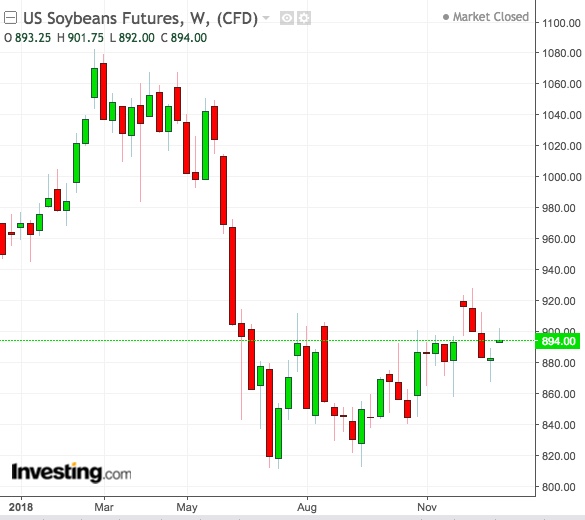Oil might not be the only commodity keeping traders awake at night over its direction in 2019. Soybeans is also extending the enigma on its price path, with just two months left on the temporary trade truce that’s key to ensuring US farmers’ continuous sale of the oilseed to China.

US soybean futures finished 2018 down 7 percent as traders remained wary of bidding the market up strongly after just two US-origin soybean shipments passed into China in December, following the 90-day deal between presidents Donald Trump and Xi Jinping to freeze all mutual tariff hikes. Prior to the two shipments, there were none from US to China since July, after Beijing slapped a 25 percent tariff on US soybeans, in retaliation for a similar duty, from Washington, on $34 billion of Chinese imports.
With a month having lapsed since the December 1 tariffs truce, there is hope for further progress now with Deputy US Trade Representative Jeffrey Gerrish and Treasury Undersecretary for International Affairs David Malpass scheduled to travel to Beijing on January 7 for follow-up talks, Bloomberg reported.
But optimism isn’t necessarily translating into price clarity.
Shawn Hackett of Florida-based agricultural markets consultancy Hackett Financial Advisors wrote in a note on Monday that while smart-money selling had removed the buy signal on soy, the market “remains in an overall neutral to bullish posture.”
Cloudy Outlook Extends Into New Year
Jack Scoville, senior grains analyst at The Price Futures Group brokerage in Chicago indicates that from a supply-demand perspective, soy’s cloudy outlook through 2018 was little changed for now.
“The market knows that there are plenty of soybeans to sell from the US and South America. South American weather has been less than perfect this year as it has often been too wet in Argentina and southern Brazil and too dry in western Parana and parts of Mato Grosso and Mato Grosso do Sul.”
Notwithstanding reports of losses in the early harvest areas of western Parana and Mato Grosso, Scoville points out that “expectations of a big Brazil crop remain.” He added:
“Private estimates range from about 120 million tons to about 123 million tons right now. That means the crop could be slightly bigger or slightly less than a year ago.”
More than any product trapped in the US-China trade war, soybeans are the commodity that could prompt the two countries to settle their dispute. Soybean and its associated product soymeal are used by the Chinese to feed the pigs they grow for pork, the country’s top protein source. China obtained 60 percent of its soy needs from the US during the 2017 crop marketing year ending September, in sales worth some $12 billion. But if the trade feud drags on, it could cost an estimated $4.6 billion in US soy sales in the 2018/19 crop year, hurting hundreds of thousands of farmers, many in the red states that voted for Trump in 2016.
Hackett says his smart-money analysis supports a positive outcome for soybeans from the upcoming trade talks in Beijing. But he adds that the backdrop of less US planted acres against a behemoth US/global ending-soybean inventory for 2018 will likely keep the market and most analysts on guard and turn any post-China trade deal rally into a “bearish hangover.”
Since its last settlement of $8.94 per bushel on the Chicago Mercantile Exchange, the benchmark March futures contract for soybeans has been rated a “Strong Sell” by technical analysts on Investing.com, based on a daily technical outlook. Third-Level Support on the Woodie’s technical chart is pegged at $8.9150—meaning a further projected loss of 2.5 cents per bushel at least. Hackett says:
“Our smart-money oscillator did trigger a short-term sell signal at the recent highs’ overhead resistance near $9.50. That made sense for those needing to make short term sales.”
Compared to soybeans, soymeal performed relatively better in 2018, ending just about 1 percent down following a September-November rally on speculation of a fully-fledged US-China trade deal. Said Hackett:
“We would still favor the purchase of March or April out of the money call options as a way for end users to protect a possible short-term price spike resulting from a China trade deal.”
